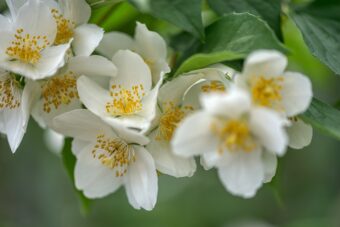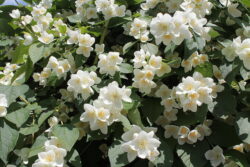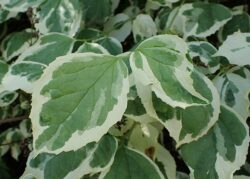In this article, we will discover how to grow the firm favourite of Philadelphus or Mock Orange in containers. Philadelphus is a genus of around 60 species of shrubs that belong to the Hydrangeacae (the Hydrangea) family. The shrubs in this genus grow anyway between 1 to 6m tall. Philadelphus are native to North and Central America, Asia and Southern Europe. The genus gets its name from the ancient King of Egypt Ptolemy II Philadelphus. The common name of Mock Orange comes about as the flowers have a strong orange-like fragrance.

The majority of Philadelphus are deciduous but a few of them from Southern regions are evergreen. The great value is Philadelphus is that it produces masses of blooms in the high summer gap between spring flowers and the bright colours of autumn. The green leaves are opposite, simple with serrated margins, and are 1cm to 4cm long. The flowers that appear are white or off-white and tower above the leaves. The blooms are commonly made up of four petals and sepals and are up to 1 to 4cm in diameter. What is common to most species is the sweet scent of the orange-like blooms, which are followed by small capsules containing numerous small seeds.
Philadelphus has a reputation for being easy to grow as it will grow in poor soils, windy sites and salt-laden airs, but will not do well in deep shade.
Find out how to grow Philadelphus in containers in this article.
GROWING PHILADELPHUS IN CONTAINERS
First, choose a large container whose diameter is greater than 30cm. No matter what you choose, make sure it has plenty of drainage holes at the bottom and will suit the shrub in question. You can buy Philadelphus as bare root plants, which should be planted between November to March. Pot-grown plants can be planted at any time of the year but are better in spring or autumn.
Fill the selected container with a 2cm layer of gravel to aid drainage even further. On top of this, add up to 5cm below the top rim with multipurpose compost. Dig a hole at the centre of the container slightly bigger than the root ball it came in the original pot you purchased it in or if you bought a bare root specimen, dig a hole at the centre deep enough so that the plants and roots, conformably fits in the container. Place the plant in so that the top of the root ball is at the same level as the top surface of the compost in the container.
For a bare root, shrub place the plant in so that all the roots are spread out in the hole and that it is planted at the same level it was in the ground it was dug up from (you can tell this at the soil marks should be easily observed on the trunk).
Backfill with the growing media so that no gaps remain, using more compost if you deem it to be necessary. Firm the plant in and water well to allow the compost to settle around the roots. Cover the soil surface with a mulch of woodchips.
THE BEST GROWING CONDITIONS

Place the container and plant in full sun or light shade, but the sun is its preferred choice.
You will need to water regularly during the first growing season to allow it to establish well, so water when the surface of the compost feels dry to the touch. After that, water when 5cm below the top surface of the compost feels dry to the touch and when you water do so until it emerges from the drainage holes.
It is recommended that you feed your Philadelphus every spring with a slow-release, general-purpose fertilizer, especially so if the plant does not look at its best.
You do not need to remove any spent flowers as they will only flower once per year and deadheading does not improve the next flowering period or growth in any way.
Pruning of young plants consists of removing dead, diseased or damaged branches after it has finished flowering. Any crossing branches or those growing in the centre should also be removed to create an open structure.
For mature Philadelphus, immediately after it has finished flowering, cut out about one-third of the old stems that have bloomed. Make sure the shrub does not have too many stems as this can spoil the show.
To propagate, you can take softwood cuttings and place them in a cold frame in early summer, or you can take semi-ripe cuttings in Mid-summer and place these in a cold frame. A final method is to take hardwood cuttings in late autumn and leave them in the open, it can take up to 3 years for the cuttings to flower.
PESTS AND DISEASES
Philadelphus tend to be attacked by aphids in early summer. This is easily observed are the young leaves start to curl. If the pests become a menace, you can start to use a systemic insecticide that can deal with this problem or you can try to blast them off by using blasts or jets of water.
Luckily the plant does not suffer from diseases, so makes a good addition to container gardening.
VARIETIES TO GROW
You do have plenty of choices and most are sold based on a variety of names rather than species.
The following varieties are recommended including ‘Belle Etoile’ which grows up to 1.5m tall.

For low-growing Philadelphus, you have the purple-blotched flowers of ‘Sybil’ and the white-edged green leaves of ‘Variegatus’ which grows up to 1.5m tall.
Philadelphus ‘Sweet Clare’ grows up to 75cm tall but for a 1m tall, compact variety, you can grow ‘Silver Showers’ that have single, very fragrant flowers.
The most popular dwarf is the 60cm tall ‘Monteau d’Harmine’ that has double, creamy-white flowers,
‘Little White Love’ grows up to 90cm tall with large, double-white flowers that are highly fragrant.
‘Pearls of Perfume’ grow up to 1.2m tall and are the first to flower all through summer. It produces large, fully double-white flowers.
‘Snowbelle’ produces large snow-like, double blooms and it grows up to 1.2m tall.
CONCLUSIONS
In this article, we have discovered how to grow the beautiful shrub of Philadelphus in containers. They look good, they smell good, are easy to look after, easy to care for and generally pests and diseases free.
So why not grow one today? If you have any questions or comments that you wish to make on growing Philadelphus in containers, please do so in the comment box below.
Happy Philadelphus growing.
